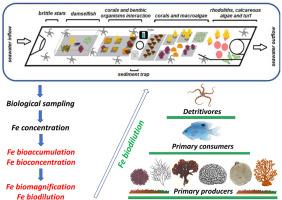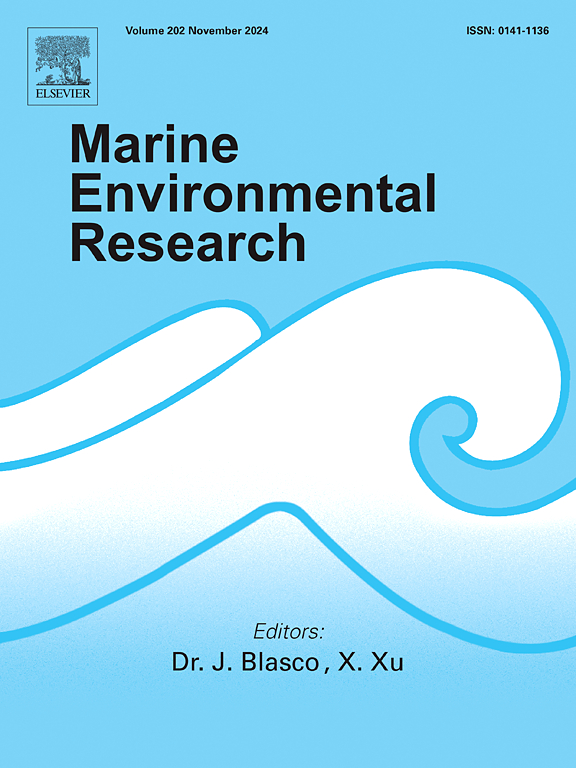珊瑚礁生物中的铁积累和珊瑚礁食物网中的生物稀释:一种中生态方法
IF 3.2
3区 环境科学与生态学
Q2 ENVIRONMENTAL SCIENCES
引用次数: 0
摘要
铁(Fe)是海洋生物必需的金属,但在过高的环境浓度下,它会引起生态生理上的不利影响。在本研究中,研究了铁在几组珊瑚礁生物中的生物积累:草皮藻、rhodoliths、肉质大型藻类(Sargassum sp.和loophora variegata)、珊瑚(Millepora alcicornis、Mussismilia harttii和Siderastrea sp.)、鱼类(stegastus fuscus)和海蛇尾(Ophioderma appressum)。采用海洋中生态系统,在不添加铁(对照条件)或增加溶解铁浓度(100、300和900 μg L−1)的海水中培养生物28天。在未添加铁的海水中,珊瑚骨骼和海蛇尾臂的铁浓度最低(1.91 ~ 4.61 μg−1干重),而巨藻和鱼肝脏的铁浓度最高(184 ~ 210 μg−1干重)。暴露于不断增加的海水中铁浓度(14或28天)后,草皮藻类、珊瑚(骨骼和组织)、鱼类(肌肉、鳃和肝脏)和海蛇尾(臂和盘)没有积累铁。另一方面,rhodoliths(4.35倍)和大型藻类(Sargassum sp.: 5.81倍;l.s variegata: 4.51倍)中观察到铁的生物积累。大藻的生物浓缩因子值(646-1319)显著高于其他生物基质(8.14-229)。这一发现证明了铁在主要初级生产者中的生物积累,并强调了铁对珊瑚礁影响的潜在风险,因为这种金属的溶解浓度过高。对照条件和铁(900 μg L−1)处理28 d后的食物网放大系数(FWMF)分别为0.481和0.404。在所有测试的溶解铁浓度和暴露时间中,在整个分析的珊瑚礁食物网中观察到铁的一般生物稀释(FWMF <1.00)。本文章由计算机程序翻译,如有差异,请以英文原文为准。

Iron bioaccumulation in coral reef organisms and biodilution in the reef food web: A mesocosm approach
Iron (Fe) is an essential metal for marine organisms, but at excessive environmental concentrations, it can cause ecophysiological adverse effects. In the present study, Fe bioaccumulation was investigated in several groups of reef organisms: turf algae, rhodoliths, fleshy macroalgae (Sargassum sp. and Lobophora variegata), corals (Millepora alcicornis, Mussismilia harttii and Siderastrea sp.), fish (Stegastes fuscus), and brittle star (Ophioderma appressum). Organisms were kept in seawater without Fe addition (control condition) or in incrementing concentrations of dissolved Fe (100, 300, and 900 μg L−1) for 28 days, using a marine mesocosm system. In seawater without Fe addition, coral skeletons and brittle star arms showed the lowest Fe concentration (1.91–4.61 μg g−1 dry weight) while macroalgae and fish liver exhibited the highest Fe concentration (184–210 μg g−1 dry weight). After exposure (14 or 28 days) to the incrementing concentrations of Fe in seawater, turf algae, corals (skeleton and tissue), fish (muscle, gill, and liver) and brittle star (arm and disc) did not accumulate Fe. On the other hand, Fe bioaccumulation was observed in rhodoliths (4.35-fold) and macroalgae (Sargassum sp.: 5.81-fold; L. variegata: 4.51-fold). Bioconcentration factor values were markedly higher in macroalgae (646‒1319) than in the other biological matrices evaluated (8.14–229). This finding evidences Fe bioaccumulation in key primary producers and highlights the potential risk of Fe impacts in coral reefs because of excessive dissolved concentrations of this metal. Food web magnification factors (FWMF) in the control condition and after Fe exposure (900 μg L−1) for 28 days corresponded to 0.481 and 0.404, respectively. Across all tested dissolved Fe concentrations and exposure times, a general biodilution of Fe (FWMF <1.00) was observed throughout the analyzed reef food web.
求助全文
通过发布文献求助,成功后即可免费获取论文全文。
去求助
来源期刊

Marine environmental research
环境科学-毒理学
CiteScore
5.90
自引率
3.00%
发文量
217
审稿时长
46 days
期刊介绍:
Marine Environmental Research publishes original research papers on chemical, physical, and biological interactions in the oceans and coastal waters. The journal serves as a forum for new information on biology, chemistry, and toxicology and syntheses that advance understanding of marine environmental processes.
Submission of multidisciplinary studies is encouraged. Studies that utilize experimental approaches to clarify the roles of anthropogenic and natural causes of changes in marine ecosystems are especially welcome, as are those studies that represent new developments of a theoretical or conceptual aspect of marine science. All papers published in this journal are reviewed by qualified peers prior to acceptance and publication. Examples of topics considered to be appropriate for the journal include, but are not limited to, the following:
– The extent, persistence, and consequences of change and the recovery from such change in natural marine systems
– The biochemical, physiological, and ecological consequences of contaminants to marine organisms and ecosystems
– The biogeochemistry of naturally occurring and anthropogenic substances
– Models that describe and predict the above processes
– Monitoring studies, to the extent that their results provide new information on functional processes
– Methodological papers describing improved quantitative techniques for the marine sciences.
 求助内容:
求助内容: 应助结果提醒方式:
应助结果提醒方式:


